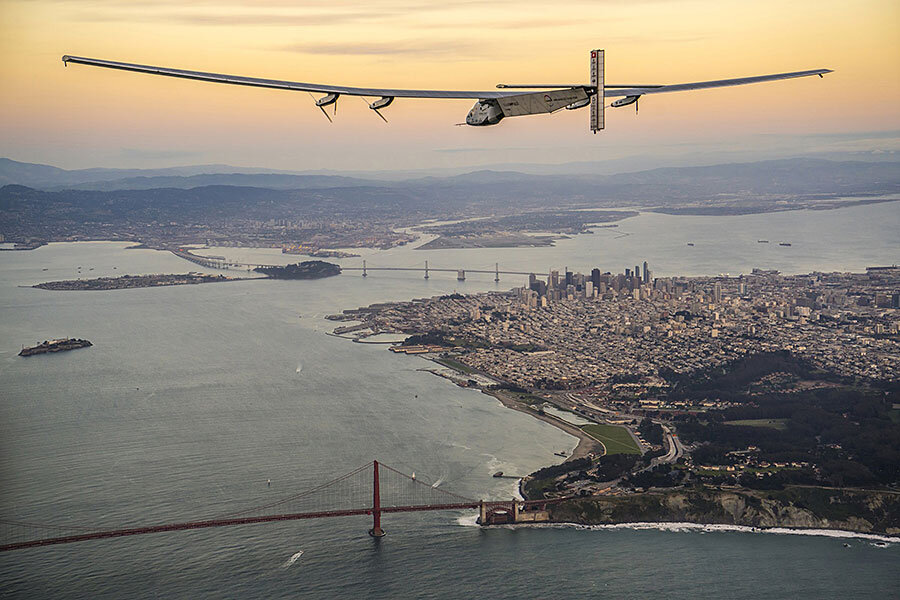Solar-powered aircraft, Solar Impulse 2, completes trans-Pacific flight
Loading...
An airplane, powered only by the sun, landed in Mountain View, Calif., early Sunday morning after three days of continuous flying from Hawaii.
Solar Impulse 2, a sleek bird made of carbon fiber and a honeycombed foam, with its expansive wings covered in encapsulated solar cells, made its ninth landing this morning, as part of its 27,000-mile journey around the world.
The goal of the adventure, headed by co-pilots Bertrand Piccard, a Swiss psychiatrist, and André Borschberg, a Swiss engineer and entrepreneur, is to draw attention to the promise of clean technologies.
"It's a new era. It's not science fiction. It's today," Piccard told CNN this morning. "It exists and clean technologies can do the impossible," he said.
With a wingspan larger than that of a Boeing 747 Jumbo Jet, but just weight of a family car, the plane took off from Oahu, Hawaii on Thursday. This was its first flight since a problem with overheating batteries grounded the Solar Impulse 2 for almost 10 months.
Before the setback, the aircraft broke records for consecutive solo flying, with Mr. Borschberg soaring for five days and nights in July over the Pacific Ocean, from Nagoya, Japan to Hawaii.
"I feel exhilarated by this extraordinary journey,” he said at the time. “I have climbed the equivalent altitude of Mount Everest five times without much rest,” said Borschberg.
The plane was supposed to land in Abu Dhabi, where it started its journey in March 2015, by the end of the summer last year. But overheated batteries caused damage that required extensive repair, so the trip was delayed until this month. Now, the Solar Impulse 2 has new batteries, a new cooling system, and an infusion of $20 million to continue its journey, as CNN reports.
The plane will make several more stops across North America, and then hopes to cross the Atlantic Ocean to Europe or northern Africa, with its final retreat to Abu Dhabi.
The hope for the epic journey, which has already generated excitement around the globe – Google co-founder Sergey Brin made a surprise appearance at the landing this morning – is that it will ignite the public’s passion for renewable technologies and more efficient use of energy.
“We want to demonstrate the importance of clean technologies for sustainable development; and to place dreams and emotions back at the heart of scientific adventure,” writes the company on its website. The co-pilots and founders wanted to show that the project is not sci-fi, “but eccentric enough to appeal to the people’s emotions and get their adrenaline pumping,” the Solar Impulse website says.
Though the Solar Impulse 2 is hugely impressive – it’s the largest aircraft built with such a low weight (5,000 pounds) – it’s not about to revolutionize commercial aviation, one of the most polluting activities on Earth.
“For commercial purposes, the Solar Impulse 2 obviously isn't very useful as is. It can only carry two people and travels at top speeds of just 43 miles per hour. By contrast, a Boeing 747-400 can carry more than 400 people and travel at top speeds of 570 miles per hour,” as Vox senior editor Brad Plumer wrote in March.
“So unless there's some truly radical advance in solar-cell technology, we're unlikely to see solar-powered aircraft that can carry many passengers or heavy cargo in the foreseeable future,” Plumer wrote.
The Solar Impulse 2 has 17,000 solar cells covering its 236-foot wings. It uses the energy from the sun to fly during the day, storing excess energy in lithium-polymer batteries that help power the aircraft at night.
The first iteration of the aircraft, Solar Impulse 1, crossed the United States in 2013.








